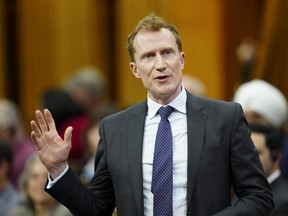Caps on students, asylum seekers and temporary workers to be introduced this fall
Article content
Prime Minister Justin Trudeau’s government will be limiting the number of temporary residents entering Canada by introducing caps on them for the first time starting this fall as it tries to tackle the ongoing housing crisis and curb inflation.
There are currently about 2.5 million temporary residents in Canada, which constitutes about 6.2 per cent of the overall population. They include students, asylum seekers and temporary workers. Immigration Minister Marc Miller on Thursday said he hopes to reduce this figure to about five per cent over the next three years.
Advertisement 2
Article content
Article content
Miller will be consulting provincial and territorial counterparts to finalize an annual target for temporary residents, similar to what the federal government currently does for its permanent residents through Canada’s annual levels planning.
“As global conditions change, as our labour market tightens and as the types of skillsets we look for in our future workforce evolves, so should our policies,” he said at a press briefing in Ottawa. “We need to be more strategic in how we assess demand and the international students and temporary foreign workers that we are welcoming.”
Currently, 42 per cent of temporary residents are students, nine percent are temporary workers under the temporary foreign workers program, while 44 per cent are workers under the international mobility program, which includes post-graduate work permits, spousal work permits for students and workers arriving through inter-company transfers or arrivals through humanitarian pathways, including those fleeing Ukraine.
Canada relies on immigrants to boost its economy and replace its aging population. But record population growth in the past two years, primarily due to a rise in temporary residents, in the midst of a housing crunch has led economists and think tanks to urge Ottawa to provide more clarity on how it plans to accommodate hundreds of thousands of newcomers every year.
Article content
Advertisement 3
Article content
The introduction of targets for temporary residents is the federal government’s latest step in tackling the situation. Canada imposed a two-year cap for new international students last year and restricted eligibility for work permits for post-graduates and their spouses. Last year, the government also decided against increasing the number of permanent residents it aims to bring in from 2026 onward.
The ultimate goal, Miller said, is to ensure a “well-managed, sustainable immigration system built on needs rather than profitability at the cost of integrity and sustainability.”
Canada needs to reset its immigration policy instead of looking for a “quick fix” to tackle its declining labour productivity issue, the Bank of Nova Scotia said in a report released Thursday.
It urged the government to invest more so that newcomers can get the tools they need to boost productivity and to also focus more on economic migrants.
The report provided two scenarios in which Canada’s productivity would have remained flat instead of declining in the past two years. The first was to restrict annual population growth to 350,000 instead of the eventual million-plus growth. The report said a rare 15 per cent rise in business investment could have also done the same job by equipping people with the necessary tools to increase efficiency.
Advertisement 4
Article content
Recommended from Editorial
-

Temporary foreign workers increasingly employed in low-paying jobs
-

Canada’s job gains double expectations
-

Newcomers to Canada tone down expectations
“Everybody talks about productivity and output per worker, because it’s a signal for welfare and standard of living,” Rebekah Young, one of the two economists who authored the report, said. “If that declines over time, everybody will be worse off. And that takes some time before we feel it.”
Canada’s gross domestic product (GDP), which measures the value of goods and services produced during a specific time frame, grew by 0.2 per cent in the fourth quarter of 2023, but its GDP per capita, which divides the GDP figure by population, has declined in five out of the past six quarters, economists say.
• Email: nkarim@postmedia.com
Bookmark our website and support our journalism: Don’t miss the business news you need to know — add financialpost.com to your bookmarks and sign up for our newsletters here.
Article content
Canada to put a cap on temporary residents for the first time
2024-03-21 18:53:09






